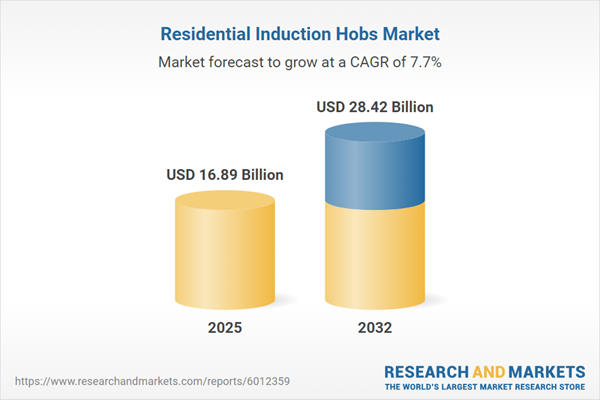Speak directly to the analyst to clarify any post sales queries you may have.
The residential induction hobs market is experiencing significant evolution, driven by a sharpened focus on energy efficiency, regulatory changes, and advanced technologies. Senior decision-makers seeking stable growth and long-term operational resilience must proactively respond to a shifting landscape shaped by these global trends.
Market Snapshot: Residential Induction Hobs Market
Between 2024 and 2032, the global residential induction hobs market is projected to expand from USD 15.65 billion to USD 28.42 billion, registering a compound annual growth rate of 7.74%. This growth underlines robust adoption of induction cooking solutions across diverse residential settings. A combination of energy efficiency, smart features, and advanced user controls supports this steady upward trajectory. Established and new market players prioritize investments in innovation and digital capabilities, while regulatory compliance and supply chain fortification remain central to their strategies. The market landscape is shaped by efforts to deliver seamless kitchen experiences and to address emerging regulatory and consumer demands for sustainability and technological integration.
Scope & Segmentation of the Residential Induction Hobs Market
This report offers actionable segmentation designed to help executive teams structure response strategies and allocate resources efficiently across a complex, evolving market environment:
- Product Type: Built-in, freestanding, and portable models address varying installation requirements, ranging from permanent modern renovations to mobile, space-sensitive uses.
- Sales Channel: OEMs, specialty retail, online marketplaces, direct manufacturer platforms, and appliance shops serve a broad spectrum of purchasing preferences and expand brand visibility.
- Number of Burners: Two, four, six, or eight burner options allow precise alignment between product offerings and diverse household cooking patterns, supporting both compact and larger living spaces.
- Price Range: Value-tier, mid-tier, and premium offerings enable market coverage across different consumer expectations, while facilitating tailored after-sales engagement.
- Technology: Single and bridge induction systems offer flexible support for various cookware formats and underpin integration within connected home infrastructures.
- Control Type: Knob, slide, and touch interfaces cater to ergonomic preferences, enhancing accessibility and supporting contemporary kitchen design trends.
- Power Output: Outputs range from below three kilowatts to over six kilowatts, matching requirements from energy-sensitive households to more intensive performance needs.
- Installation Type: Drop-in and surface-mount choices provide adaptability for renovation projects and new builds, supporting a wide range of interior design preferences.
- Regional Scope: The Americas, Europe, Middle East and Africa, and Asia-Pacific form core analytical regions, with particular attention paid to evolving regulations and adoption in China, India, the United States, Germany, the United Kingdom, and Brazil.
- Key Companies: BSH Hausgeräte GmbH, Whirlpool Corporation, Haier Group Corporation, Electrolux AB, Midea Group Co. Ltd, Samsung Electronics Co. Ltd, LG Electronics Inc., Panasonic Corporation, Arçelik A.Ş., and Miele & Cie. KG drive industry advancement through targeted innovation and market engagement.
Key Takeaways for Senior Decision-Makers
- The rapid integration of smart features and connected controls in induction hobs is reshaping user engagement and driving preferences for remote management and safety automation.
- Synchronizing digital and in-person retail strategies ensures brands remain relevant across evolving channels, improving the overall customer journey and bolstering loyalty.
- Focusing on agile procurement and supplier relationships reinforces resilience amid shifts in regulatory constraints and variable operational environments.
- Investing in modular product architectures positions organizations to adapt swiftly to new regulations and market requirements, supporting ongoing compliance and technological advancement.
- Emphasizing predictive, high-quality after-sales service strengthens brand trust and secures ongoing retention across developed and emerging markets.
Tariff Impact on Strategic Market Approaches
Recent changes in United States tariffs are influencing procurement and sourcing strategies throughout the residential induction hobs sector. To withstand ongoing trade uncertainties, companies are adopting supplier diversification and negotiating extended contract terms to protect supply continuity. Flexible pricing structures and scenario-based planning further assist organizations in mitigating the impact of volatile trade policies and maintaining strategic decision-making agility.
Methodology & Data Sources
This report’s insights draw from direct interviews with senior industry leaders, rigorous technical assessments, and comprehensive secondary research. Each data point included has been independently validated, ensuring that conclusions meet the strategic requirements of senior decision-makers.
Why This Report Matters
- Supports leadership in benchmarking technology adoption and guiding effective, future-proof portfolio strategies within the residential induction hobs space.
- Arms procurement and operations teams with practical guidance to navigate global sourcing dynamics and regulatory developments.
- Facilitates informed product design and channel diversification decisions in light of shifting consumer and policy expectations.
Conclusion
Companies that invest in adaptable product designs, resilient supplier networks, and integrated multi-channel strategies are better positioned to navigate industry changes. Continued flexibility and operational readiness are essential for sustainable growth as market conditions evolve.
Additional Product Information:
- Purchase of this report includes 1 year online access with quarterly updates.
- This report can be updated on request. Please contact our Customer Experience team using the Ask a Question widget on our website.
Table of Contents
3. Executive Summary
4. Market Overview
7. Cumulative Impact of Artificial Intelligence 2025
Companies Mentioned
The companies profiled in this Residential Induction Hobs market report include:- BSH Hausgeräte GmbH
- Whirlpool Corporation
- Haier Group Corporation
- Electrolux AB
- Midea Group Co., Ltd
- Samsung Electronics Co., Ltd
- LG Electronics Inc.
- Panasonic Corporation
- Arçelik A.Ş.
- Miele & Cie. KG
Table Information
| Report Attribute | Details |
|---|---|
| No. of Pages | 194 |
| Published | November 2025 |
| Forecast Period | 2025 - 2032 |
| Estimated Market Value ( USD | $ 16.89 Billion |
| Forecasted Market Value ( USD | $ 28.42 Billion |
| Compound Annual Growth Rate | 7.7% |
| Regions Covered | Global |
| No. of Companies Mentioned | 11 |









